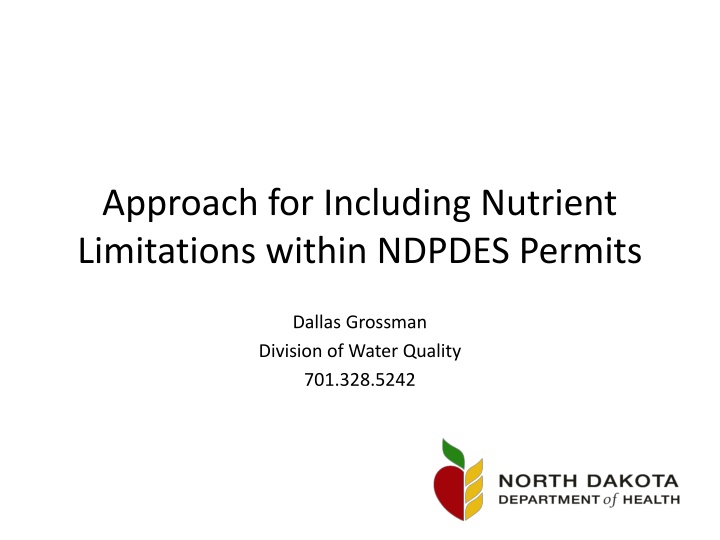
Managing Nutrient Limitations in NDPDES Permits
This approach outlines the inclusion of nutrient limitations within NDPDES permits to protect receiving streams and water bodies. It covers the development of loads and concentrations, technological and water quality-based effluent limitations, and the translation to permit regulations. Considerations include total nitrogen and phosphorus levels, critical stream and effluent flows, and setting up nutrient trading programs.
Download Presentation

Please find below an Image/Link to download the presentation.
The content on the website is provided AS IS for your information and personal use only. It may not be sold, licensed, or shared on other websites without obtaining consent from the author. If you encounter any issues during the download, it is possible that the publisher has removed the file from their server.
You are allowed to download the files provided on this website for personal or commercial use, subject to the condition that they are used lawfully. All files are the property of their respective owners.
The content on the website is provided AS IS for your information and personal use only. It may not be sold, licensed, or shared on other websites without obtaining consent from the author.
E N D
Presentation Transcript
Approach for Including Nutrient Limitations within NDPDES Permits Dallas Grossman Division of Water Quality 701.328.5242
Receiving Stream Protect the near-field and far-field waterbody River/stream/lake Based on a water quality standard (narrative), total maximum daily load (TMDL), observed impacts, response variables, accelerated monitoring Total nitrogen for streams Total phosphorus for lakes and reservoirs 10/14/2014 2
Developing Loads and Concentrations Technology Based Effluent Limitation (TBEL) Water Quality Based Effluent Limitation (WQBEL) Certain types of facilities will have established TBELs Other types, such as Publicly Owned Treatment Works (POTWs), may have WQBELs More stringent WQBELs could be applied to facilities with TBELs 10/14/2014 3
Developing Loads and Concentrations Need to consider magnitude, duration and frequency of the discharge and loading Review background and support documentation, as well as response variables Existing TMDL 2000 Ecoregional Nutrient Criteria 1986 Gold Book Chloraphyll a 10/14/2014 4
Developing Loads and Concentrations Can use the U.S. Environmental Protection Agency s Technical Support Document to conduct a reasonable potential analysis to determine loads and concentrations Selection of critical stream and effluent flow will need to be established Selection of critical stream and effluent concentrations will need to be established 10/14/2014 5
Translation to a Permit Individual and general permits Standard individual and general permits for facilities in a watershed may have different permit cycles Watershed permits One permit for all facilities in a watershed The effluent limitations for each facility in the watershed are established at the same time 10/14/2014 6
Translation to a Permit Nutrient trading Probably want to avoid Have to set up a nutrient trading program Contracts between facilities Facilities with TBELs cannot trade above the TBEL 10/14/2014 7
Translation to a Permit Variances Probably try to avoid variances for small lagoon system Small lagoons may be a small contributor May require seasonal discharges instead 10/14/2014 8
Translation to a Permit Seasonal limitations Different limitations may be established based on the season (summer vs. winter) Compliance schedules may be established to meet limitations Antidegradation procedures will need to be followed if a facility cannot meet nutrient limitations 10/14/2014 9
Conclusion The North Dakota Department of Health will need to establish protocols for including nutrient criteria within permits Background information that will be considered Critical flows and concentrations Permitting approach (individual, general and watershed permits) Nutrient trading Variances Type of limitations Compliance schedules Antidegradation 10/14/2014 10
Discussion 10/14/2014 11
